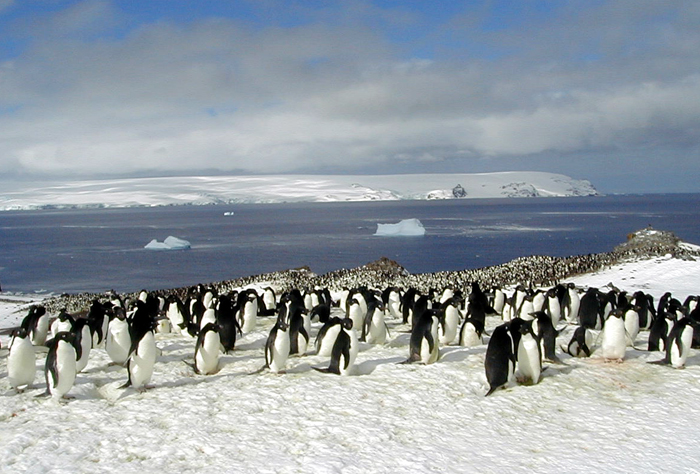|
Going on a dietPenguins' primary prey reveals drastic changes in climatePosted November 26, 2008
There’s an old saying: You are what you eat. But the krill-based diet of penguins breeding and living on King George Island off the northern end of the Antarctic Peninsula first tipped scientists off that food could provide an altogether different insight. “It was the penguins that actually keyed us into to the global change scenario that has become the leading hypothesis about climate change in the peninsula region,” explained Wayne Trivelpiece Trivelpiece, along with his wife and co-principal investigator, Susan Trivelpiece “Studying all three [penguins] at once has given us some real insights into just what happens when we come across some major changes in environmental features and climate, which has certainly happened there,” Wayne Trivelpiece said. Krill That’s directly affected the abundance of krill and the survival rates of penguins. In the 1970s and early 1980s, Trivelpiece explained, the researchers would find krill of many different sizes and age-classes (from juveniles to old adults) as they examined the contents of the penguins’ stomachs. But into the 1980s and ’90s, bird biologists were fascinated by what they no longer saw — variety. The diets were now dominated by one age-class or size of krill each season, Trivelpiece explained. One year juveniles would dominate, and then each succeeding year the prey were a little bigger. The cycle would restart every four to six years. “As we looked at this over time, there were very logical and predictable features to the size and age classes of the krill in the diets,” he explained. “The major thing that correlated with the krill size changes was having ice in wintertime or not having ice in wintertime.” Krill were only being replenished every few years, in concert with winters that had heavy pack ice in the Antarctic Peninsula region, meaning lean sources of food for many marine predators in the intervening seasons. The Adélie and chinstrap populations, in particular, crashed by the late 1980s and early 1990s, according to Trivelpiece. The Adélie population dropped by 50 percent at King George Island by 1990. Young penguins were no longer returning to the colony to breed as they had in previous years. The early years of the study found 40 to 60 percent survived to return to their breeding colonies; less than 10 percent survive today. A krill survey in the Antarctic Peninsula region in 2000 estimated the krill population itself has dropped off by as much as 80 percent since the last survey in the early 1980s in the region. “We had a vast change in the probability that young penguins fledgling off our beaches would be seen again in the colony two to five years later as breeders,” Trivelpiece said. “They were basically starving to death in much greater degree than ever before. That trend has continued to today.” 1 2 3 Next |



For USAP Participants |
For The Public |
For Researchers and EducatorsContact UsNational Science FoundationOffice of Polar Programs Geosciences Directorate 2415 Eisenhower Avenue, Suite W7100 Alexandria, VA 22314 Sign up for the NSF Office of Polar Programs newsletter and events. Feedback Form |


